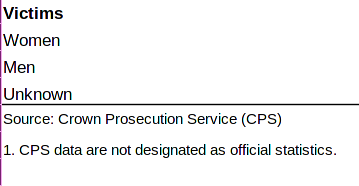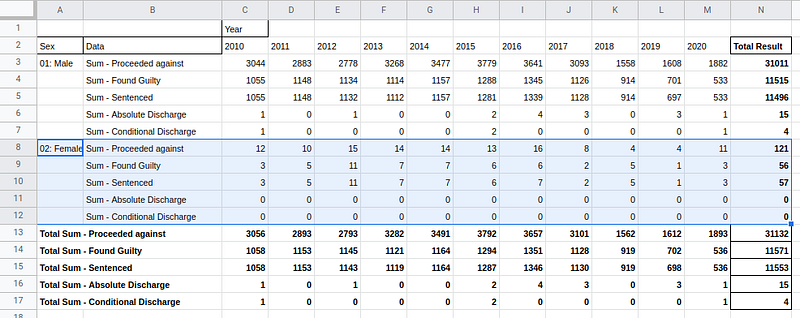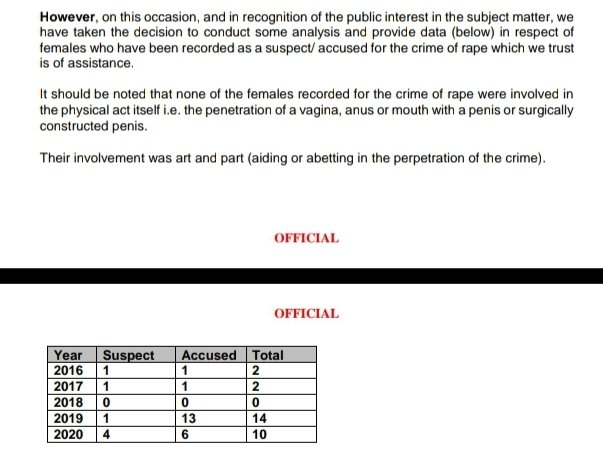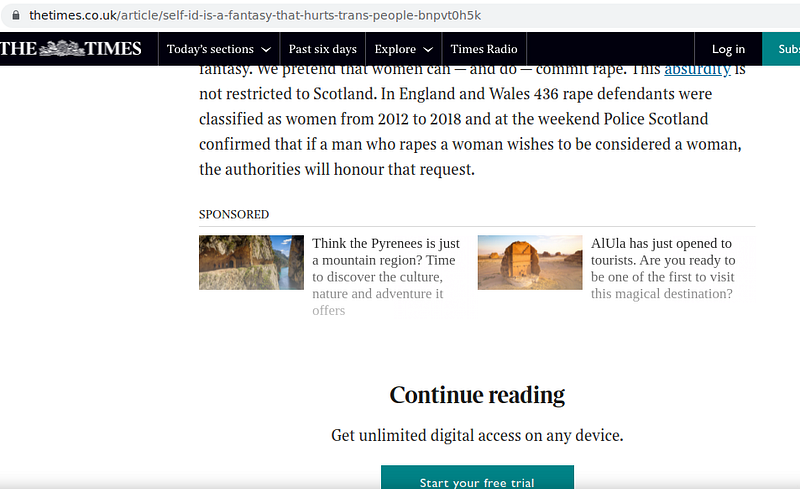Alice Sullivan and Allison Bailey are misleading the public and UK Government bodies about rape…
Content Note: Discussion of rape and crimes against minors (with no graphic detail)

Alice Sullivan and Allison Bailey are misleading the public and UK Government bodies about rape statistics and trans women in the criminal justice system
Content Note: Discussion of rape and crimes against minors (with no graphic detail)
Additionally, I am not an academic. My data background is in occasional clerical work for a local activist think tank that investigates police use of force. My understanding of data ethics and norms around verifying data sources stem from that experience. I am hoping and expecting for this to need verification by individuals with the appropriate credentials
Summary
Sociology professor Alice Sullivan made claims to the Scottish Government as well as on Twitter that suggested that there existed anomalies in criminal justice data that are related to the recognition of trans women according to their gender identity. She based this on CPS data while ignoring the accompanying documentation explaining how these statistics are collected and why there is a discrepancy between CPS data and Ministry of Justice proceedings.
Longitudinal data exists from before the period when trans suspects started getting recorded according to gender identity for the purposes of crime statistics. These data source show that there has been no change in the rate of female rape prosecutions before and after this change in policy.
Because there is no change in rape prosecutions, on average, there is no plausible connection between the figures and recognising trans women as women. This is therefore a transparent attempt to use spurious allegations of criminality to deny legitimacy to trans women.
Further to this, others such as Allison Bailey have been actively conflating Ministry of Justice data with CPS data. These disagree entirely with each other in terms of data collection, so as to create the false impression of a massive rise in rape after recognising trans women according to gender identity. In doing so, Allison Bailey is misleading the public from her Twitter account.
This has been escalated by The Times of London, and the journalist Alex Massie who have published, first on December 14th, and then republishing in January 5th, repeating the misleading claims with slight adjustments. He said “We pretend that women can — and do — commit rape.”, but that “436 defendents were classified as women from 2012 to 2018” before moving on to talk in innuendo about trans women.
As shown below, there is every reason to believe that this is a misinterpretation of statistics, shared by a sociologist in a moment of unprofessionalism. The Times have hidden their correction notice identifying this article as having been corrected behind a paywall. This further compounded the misleading claims by leading the article with the shocking and misleading opening claim only without visible indication of a correction.
Detailed analysis
Since last year a pernicious set of myths have been growing out of unofficial CPS statistics about rape allegations and prosecutions in a report released in 2018. This started with sociologist Alice Sullivan making the claim to Scottish Parliament in August of last year, that women were over-represented in rape prosecution statistics, based on the supposed rarity of women being prosecuted. This point was raised in the context of suggesting that the confounding factor in understanding these numbers was the fact that trans women have been being recorded as women for the sake of crime (with the implication that trans women must account for the number of rape prosecution statistics), saying
Documented instances of females being charged with rape as an accomplice are rare. Yet, between 2012 and 2018, this data shows that the proportion of rape defendants classified as women varied between 1.2 per cent and 1.8 per cent. During this seven-year period, 436 individuals prosecuted for rape were recorded as women.
To substantiate this claim with data, she used the dataset Sexual offending: victimisation and the path through the criminal justice system — Crown Prosecution Service Appendix Tables.
Apologies that it’s not possible to alt-text this
It is worth noting that these statistics have a disclaimer in the lower left hand corner of the spreadsheet itself, warning that CPS data are not designated as official statistics

While the link that Sullivan gave above in her report to parliament goes directly to the spreadsheet in question it is always a key task when understanding any data to understand how it was collected, where it came from, and if it lines up with other data collection methods. This is particularly important in the case where the barrister Allison Bailey has taken this point further following up from Professor Sullivan to connect up with MoJ statistics from 2011 and pointed to a discrepancy as proof that rape prosecutions for women had shot up suddenly after the Equality Act 2010 (which came into power in 2011):
As indicated by the table header, the original data that Alice Sullivan drew people’s attention to were drawn from the appendix to a 2018 report, entitled Sexual offending: victimisation and the path through the criminal justice system. Again, in the first section of this report, subheading “Main Points”, they offer the following caveat to the numbers:
The different data sources included in this article can’t be directly compared. They differ in the way they are collected in terms of timescales, units of analysis, definitions and identification processes. Together with the time lag between different stages in the criminal justice system, this means that each data source doesn’t refer to the same cases.
So we should be careful and understand how these statistics are gathered, right? Certainly that’s what any sociologist would have been trained to do.
In section 2, Statistician’s Comment, they add:
“The report highlights that investigating sexual offences is challenging. Many offences don’t proceed further than the police investigation due to evidential difficulties. In addition, investigations are becoming more complex due to an increase in evidence from phones, tablets, computers and social media.
Then in part three they list the various sources for data in the report:
- sexual offences reported to and recorded by the police
- prosecutions and convictions for sexual offences recorded by MoJ and the CPS
- sentencing for sexual offences from MoJ
They then offer these flowcharts that describe the pathway of reporting data through the police to the Crown Prosecution Service.

Crucially, this appears to be different for the Ministry of Justice, who follow the following flowchart, again, in the report where Professor Sullivan’s source data was taken from. I’ve added annotations pointing to the phase the CPS originally agree rape prosecution with the police, and contrasting with how the MOJ record prosecutions and convictions for rape.

As Professor Sullivan pointed out in the evidence she gave to the Scottish Parliament, it is very difficult for women to be prosecuted or found guilty for rape in the UK:
“Rape is classified as a male crime in UK law, and females can only be charged with rape as an accomplice.”
So we have data from the CPS at one stage with the CPS’s decision to prosecute, and then data from the MoJ at another stage where the charges might have been abandoned or changed to another offence or otherwise gotten lost in the CPS system ahead of arriving at court.
The outcomes table is not broken down by sex, so we do not know from the CPS count, what happened to the cases involving female “defendants”. However we can see a breakdown of reasons given for “unsuccessful prosecutions”, in the spreadsheet that Prof Sullivan cited.
As visible below, these include a great many cases where prosecutions are completely dropped, more than there are women who are prosecuted for rape at all. The row on the right is the figures for the year up to March 2012, during which the CPS recorded 60 women “prosecuted” for rape. 626 of these “prosecutions” were dropped, withdrawn, or discontinued ahead of trial.

However, other data exists to tell us about the outcomes for these years. These are the Ministry of Justice numbers — the numbers that Allison Bailey cited when comparing MoJ 2011 to CPS 2012–2018. For the period of 2010 to 2020 inclusive there is a pivot tool spreadsheet that allows users to filter criminal justice system outcomes by offence and sex of the attacker, as well as the provision of the underlying data.
A few reminders: We know these are going to be less than the CPS stats because:
- The CPS stats are flagged and captured at an earlier part of the criminal justice pipeline
- It is difficult to secure a trial for women for rape as most such cases will only possibly be as an accessory
- There are very few cases of charges of rape against women, 1 tenth of the number of cases which are dropped ahead of trial.
Note: the pivot tool appears to be broken on every spreadsheet application I have tried. So that people attempting to replicate my methodology are able to follow I have included instructions at the end of this article to generate your own pivot tool from the raw government data.
The following is a pivot table I produced from the MoJ statistics for rape prosecutions and outcomes (using the methodology at the end of this article).

As expected from the pipeline diagram given by the report this shows no way near as many as the supposed 436 defendents between 2012 and 2018. But we expected that because we did what any responsible citizen looking at data ought to do and we went looking at how these numbers are produced.
The number of convictions of women for rape in 2011 matches Allison Bailey’s number — 5 marked Found Guilty — because her number was drawn from the Ministry of Justice statistics, not the CPS statistics that Alice Sullivan was drawing from.
We have also comprehensively shown that the idea there were 60 prosecutions (in terms of actually leading to proceedings) against women for rape in 2012, is absolutely farcical. This takes about a day of looking at the data for anyone with basic data literacy skills.
The second thing we should note here, is that the idea that the numbers have significantly increased after the Equality Act resulted in police and prosecutors flagging trans women in the criminal justice system as female is clearly nonsense. This was Professor Sullivan’s key concern. [edit: Adjusting this remark —Sullivan doesn’t refer directly to the EA2010. She does refer to the registering of trans criminals by gender identity, which happened as a result of the EA2010, coming into effect in 2011 onwards. The implication of her claim that the data from 2012 onwards is problematic because of gender identity based recognition follows directly from this. So even without her citing the EA2010 directly her core argument hinges on changes in reporting processes that resulted from it.] But we have longitudinal data for this entire period, going back before (to 2010).
On average during the 10 year period, 2010 to 2020, there are 12.1 proceedings against a woman for rape per year. Of these, 5 per year were found guilty.
The number of proceedings per year against women for rape in 2010 (before self identification in the criminal justice system) was 12 and the number found guilty was 3. This count is entirely in line with the average for all the following years for which we have data. There is no meaningful appreciable change in the rate of rape prosecutions, other than random jitter and noise. There is absolutely no evidence here to suggest that recognition of trans women has introduced some sort of data anomaly to the wider system.
Furthermore, Alice Sullivan, a sociology professor, has patently ignored the documentation surrounding the statistics in order to foster innuendo which has been the result of alarmist articles in The Times (since retracted), and claims by others that there are 436 trans rape defendents floating around unaccounted for in the criminal justice system.
It’s worth noting that following the controversy around these irresponsibly and unprofessionally handled statistics, a Freedom of Information Request was returned by Police Scotland, where they responded that they had gone through their own files regarding rape by females and found that for every case they could find for the years 2016–2020 inclusive, “Their involvement was art and part (aiding or abetting the perpetration of the crime)”, which is to say, at least in Scotland, every single case was a case where the female accused had not used a penis of her own.

Adding to this, the Times of London’s Alex Massie published an article repeating the myth being spread on December 14th, saying
We pretend that women can — and do — commit rape. This absurdity is not restricted to Scotland. In England and Wales 436 male-bodied sex offenders were classified as women from 2012 to 2018 and at the weekend Police Scotland confirmed that if a man who rapes a woman wishes to be considered a woman, the authorities will honour that request.
This was corrected, but republished as follows on January 5th, with a correction note published separately. However, on the article itself, the accompanying correction note was hidden at the bottom, rendering it invisible to visitors to the website who were not already subscribers.

Furthermore, this suggestion that there is a discernible trans factor in the “436 rape defendants” number is still false, regardless of the removal of the suggestion that every single one of the 436 were accounted for by trans women. The correction has not really addressed or recognised this at all. In fact the article itself was republished in such a way as it is not necessarily obvious that it is in fact the December 14th article, because the date has been changed to January 5th. In doing so Alex Massie and the Times are engaged in spreading misinformation. Numerous members of the trans community have spoken out about this, including directly to Massie himself on Twitter, only to face blocking and refusal to acknowledge the problem.
Instructions for extracting the UK MoJ data manually
I used the free spreadsheet editor LibreOffice Sheets to do this with, but the process is broadly similar for Google Sheets, Office365 Excel and most other spreadsheet applications.
- Download “data-behind-interactive-tools-1.zip”.
- Unpack “all_courts_2020.csv” from it, opening it in a spreadsheet application of your choice.
- Make sure to tick “Comma” as the separator, and untick any other separators when opening the file.
- Using the menu bar: Insert->Pivot Table
- As filters, add Offence.
- As column fields add Year.
- As row fields, add Sex and Data.
- As data fields, add Proceeded Against, Found Guilty, Sentenced, and any other outcomes you would like to tally.
When filtering by offence, the filters should add the following categories (being all the Offence categories which specifically use the term “rape”, rather than “assault by penetration” or other things which might be described as rape outside of the British legal system):
- 19C Rape of a female aged 16 or over
- 19D Rape of a female aged under 16
- 19E Rape of a female child under 13 by a male
- 19F Rape of a male aged under 16
- 19G Rape of a male aged 16 or over
- 19H Rape of a male child under 13 by a male


